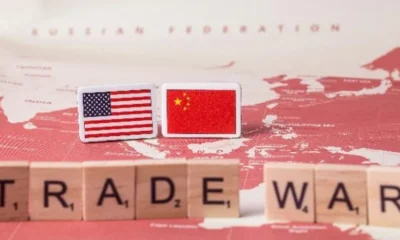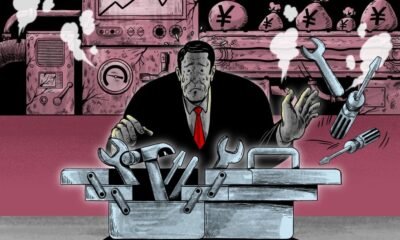Economy
China’s Economy On Its Way To Recovery? Alibaba Shares Soar 11% After Stellar Earnings, Marking an E-Commerce Revival—But What About the Pained Real Estate Sector?
Published
9 months agoon

As the Year of the Snake unfolds, China appears to be steering its economy toward a strong recovery. The nation’s economic trajectory is being shaped by a combination of increased consumer spending, policy-backed industrial expansion, and capital market optimism, all pointing to a shift toward a more sustainable, innovation-driven future.
Consumer Spending Fuels Growth
China witnessed a surge in consumer spending during the recent Spring Festival holiday, with tourism and services leading the way. Domestic travel expenditures during the eight-day holiday hit 677 billion yuan (US$94.4 billion), reflecting a 7% increase from last year. The homestay sector performed particularly well, with revenues climbing by 12.6%, as tourists sought out personalized lodging experiences with rich cultural characteristics.
Meanwhile, winter sports gained significant traction, with destinations like the Harbin Ice-Snow World drawing over 610,000 visitors. The China Tourism Academy projects that the 2024-2025 winter season will see 520 million trips, generating more than 630 billion yuan in tourism revenue.
The cultural sector also saw a notable boost, with box office revenues during the Spring Festival reaching a record-breaking 9.51 billion yuan. The number of moviegoers soared to 187 million, illustrating a strong appetite for entertainment spending.
Policy-Driven Consumer Confidence
China’s government-backed consumer goods trade-in program played a crucial role in boosting consumer sentiment. Sales of household appliances and audiovisual equipment skyrocketed by 166.4% compared to last year, while sales of communication devices saw an even sharper increase of 181.9%.
The “trade-in” concept has been gaining traction in China’s consumer market, with national campaigns driving steady retail sales growth. This initiative, coupled with strategic stimulus measures, signals the Chinese government’s commitment to stabilizing consumption and focusing on long-term economic resilience.
Industrial Expansion and Business Environment Reforms
Immediately following the holiday season, regional governments across China ramped up efforts to strengthen the real economy. Key areas of focus included industrial modernization, business environment optimization, and technological innovation.
–Guangdong, a key manufacturing hub, unveiled a 2025 action plan to develop a modern industrial system with a planned annual investment of 1 trillion yuan. The province aims to enhance high-end equipment manufacturing, petrochemicals, steel production, and more.
–Shanghai held its annual business environment conference for the eighth consecutive year, rolling out 58 new measures aimed at improving enterprise services and regulatory oversight.
–Zhejiang is fostering deeper integration between technology and industry, creating collaborative frameworks that unite universities, enterprises, and industrial platforms.
–Hubei and Hainan are placing technological innovation at the core of their development strategies, further reinforcing China’s push toward a knowledge-based economy.
Capital Markets Regain Investor Confidence
The post-holiday period has also seen renewed investor confidence in China’s capital markets. Leading financial institutions are taking a bullish stance, citing the country’s ability to sustain innovation and drive long-term growth.
Desmond Kuang, chief investment officer for China at HSBC Global Private Banking and Wealth, believes that as global investors recognize China’s innovation capabilities, the valuation gap between China and emerging markets will narrow, prompting increased foreign capital inflows.
Similarly, James Wang, head of China Strategy at UBS Investment Bank Research, predicts that thematic trading will shape China’s equity market in 2024. He states artificial intelligence (AI) as a key driver, noting that a moderately loose monetary policy could further bolster equity valuations.
Macroeconomic Outlook
According to the International Monetary Fund (IMF), China’s economy is projected to grow at a rate of 4.6% in 2025, a slight upgrade driven by recent stimulus measures. Meanwhile, the nation’s current account surplus reached US$422 billion in 2024, with a trade surplus in goods climbing by 29% year-on-year to US$767.9 billion. Despite a services trade deficit of US$228.8 billion, China’s economic structure continues to evolve toward higher-value exports and foreign investments.

Alibaba Shares Surge on Strong Earnings Report
Meanwhile, Alibaba shares soared in Hong Kong on Friday, climbing as much as 11% following impressive quarterly results, driven by robust growth in its cloud intelligence and e-commerce segments. The stock was last trading 9.18% higher.
Nomura analysts remain optimistic about Alibaba’s e-commerce business, predicting continued strength in the first half of 2025, supported by ongoing trade-in subsidies. To stimulate consumer spending, China announced last July a 300 billion yuan ($41.5 billion) allocation in ultra-long special government bonds to enhance trade-in and equipment upgrade initiatives.
Vey Sern Ling, senior equity advisor at UBP, noted that domestic e-commerce is rebounding toward sustainable growth and profitability, contributing to positive sentiment across the broader Chinese technology sector.
Chinese tech stocks have been rallying, particularly since the emergence of AI startup DeepSeek, which is challenging the U.S.-led AI ecosystem with its R1 model, boasting superior performance and significantly lower costs.
Meanwhile, Alibaba’s founder Jack Ma, who has kept a low profile since 2020, recently attended a private meeting with Chinese President Xi Jinping. During the session, Xi encouraged private enterprises to demonstrate their capabilities and strengthen their confidence in the evolving business ecosystem.
Alibaba has been recovering from regulatory scrutiny that began in 2020, when its financial technology arm, Ant Group, was forced to halt its highly anticipated initial public offering. Since then, the company has made significant progress in advancing its AI-driven cloud business. Barclays highlighted Alibaba’s flagship AI foundation model, Qwen 2.5-Max, as a key driver of growth, with AI inference demand accounting for up to 70% of new cloud service demand.
“Great opportunities require significant investment,” Barclays analysts noted, emphasizing that Alibaba’s AI and cloud infrastructure expansion over the next three years is expected to exceed the company’s total investment in the past decade—approximately 270 billion yuan.
For the quarter ended December 31, Alibaba reported a net income of 48.95 billion yuan ($6.72 billion), surpassing analysts’ expectations of 40.6 billion yuan and significantly exceeding the 14.4 billion yuan reported in the same period last year. Revenue came in at 280.15 billion yuan, slightly above analysts’ forecasts of 279.34 billion yuan.
Following the earnings announcement, Alibaba’s U.S.-listed shares jumped over 8% on Thursday, reflecting strong investor confidence in the company’s growth trajectory.

China’s Real Estate Woes Persist as Rescue Efforts Fall Short
While E-Commerce seems to be on track, China’s efforts to stabilize its struggling real estate sector have yet to deliver meaningful results, putting pressure on Beijing to explore new solutions. Analysts believe large-scale government purchases of unsold apartments may be the only way forward.
One of the key measures introduced last year—the People’s Bank of China’s (PBOC) 300 billion yuan ($41.4 billion) relending program—was expected to facilitate 500 billion yuan in loans for local government-controlled firms to buy empty homes and convert them into affordable housing. The initiative, announced in May 2024, was hailed as a turning point for the housing market.
However, progress has been sluggish. By the end of September, only 16 billion yuan had been drawn from the facility, raising concerns about its effectiveness. The program was designed to reduce China’s massive inventory of unsold apartments and improve developers’ cash flows, allowing them to complete stalled projects. But financial and operational constraints have made it difficult for state-owned enterprises (SOEs) to execute the plan.
With the property sector continuing its downward spiral since 2021, some economists suggest the government must step in with direct fiscal intervention rather than relying on market-driven solutions. The absence of updated data in the PBOC’s latest quarterly report has only fueled speculation that the program is underperforming.
Meanwhile, another government initiative allowing local governments to repurchase idle land from developers using special debt has also seen limited success. Officials remain focused on acquiring only high-return land parcels, leaving many developers struggling.
The challenge lies in balancing financial prudence with the urgent need to clear housing inventory. The existing tools were designed to avoid the risk of authorities selectively bailing out developers, especially after years of unchecked expansion in the sector. However, declining rental yields across China have made it difficult for state entities to justify large-scale purchases purely on financial grounds.
Without a meaningful reduction in unsold housing, property prices will likely continue to fall, dragging down household wealth and consumer confidence at a time when China is already grappling with deflation risks and trade tensions with the U.S.
“The constraints—moral hazard concerns and investment returns—are slowing the pace at which local governments can use relending or special bonds to clear inventory,” said Robin Xing, Chief China Economist at Morgan Stanley.
Xing estimates that China needs around 10 trillion yuan in stimulus over the next two years to counter deflationary pressures, with at least 3 trillion yuan earmarked for real estate. He argues that the government should focus on cutting the inventory of newly built, unsold homes in China’s 30 largest cities by at least half.

Why Government Rescue Plans Aren’t Adding Up
Despite Beijing’s attempts to revive its struggling property sector, financial realities are making its efforts increasingly unworkable. With an oversupply of housing and a shrinking population, rental yields in China have fallen below 2%—a figure that continues to decline. For state-owned enterprises (SOEs) tasked with buying up empty homes, the numbers simply don’t stack up.
The People’s Bank of China’s (PBOC) relending program offers commercial banks loans at 1.75% interest, with lenders adding a risk premium of around 50 basis points. Yet, even with this relatively low-cost capital, SOEs are being forced to offer prices at least 40% below market value to make the economics viable—an approach developers instantly reject.
Developers, even those in dire need of cash, are holding firm. Analysts point out that Beijing has a strong incentive to stabilize home prices at higher levels, fearing the broader economic fallout of a steep decline.
“If developers sell some buildings to the local government at a 50% discount, how would homeowners in that area perceive the future price of their homes?” said John Lam, Head of Greater China Property Research at UBS Investment Bank. “If the government thinks these homes are only worth half their price, doesn’t that signal to homeowners that they should sell quickly too?”
A similar financial logic applies to the government’s special debt-funded land repurchase program, which has so far yielded minimal results. A February 12 report by China Real Estate Information Corporation found that purchases across seven cities totaled just 17.1 billion yuan.
Developers say the problem is clear – SOEs are only interested in high-quality land with strong return potential. “If my land was that valuable, I wouldn’t have trouble selling it in the first place,” said one developer, who requested anonymity due to the sensitivity of the topic.
Beyond financial hurdles, operational challenges further complicate the situation. To minimize property management costs, SOEs prefer to buy completed, fully vacant buildings. But such projects are rare—Chinese developers primarily rely on pre-sales to fund construction, meaning most developments are partially sold before they’re even completed.
For now, China’s property market remains in limbo, caught between government rescue efforts that developers won’t accept and an economic reality that demands urgent solutions.
You may like
-


Taiwan’s ‘Historic’ TSMC Deal, A Win Or The End Of Its ‘Silicon Shield’ As China Threatens? A Jittery Taiwan Watches Trump’s Moves On Ukraine, Wondering, Could We Be Next?
-


A Trade War That Just Won’t Quit. As Trump’s Tariffs Hit, China Stays The Course, For Xi’s Its Business As Usual Strategy
-


Indian Stock Market In Turmoil. Investors In Panic Mode, Is This A Temporary Correction Or The Start Of A Bear Market?
-


America And China’s Thirst For Gold In 2025 Is Draining Other Countries’ Reserves; Here’s Why?
-


China To Cut Inflation Outlook To 20-Year Low, Eyes Fresh Stimulus At ‘Two Sessions’ To Boost Economy
-


Shakeup In The Auto Sector. Mercedes-Benz 15% Job Cuts, Nissan CEO Exit, And Germany’s Make-Or-Break Year
